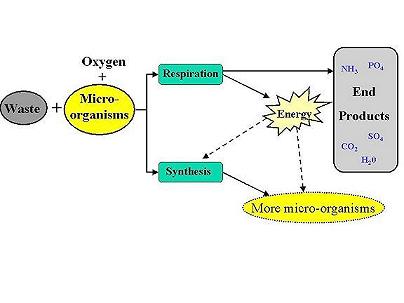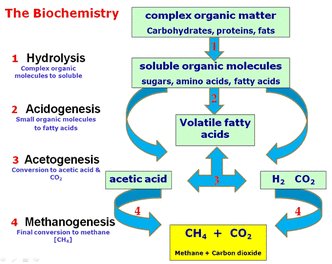There are two types of decomposition: aerobic (with oxygen, Figure 1) and anaerobic (without oxygen, Figure 2). Aerobic decomposition turns organic matter, nutrients, and dissolved oxygen into biomass in the form of humus, nutrient compounds, carbon dioxide, and new decomposing microorganisms. This process creates energy; some is used by the organisms, but most is released as heat.
Both processes have advantages and disadvantages. Anaerobic creates little heat and less solid end-product as much is released as gas, however, it also quite odorous. The heat produced by aerobic decomposition sterilizes the final solids of pathogenic organisms and, if it can be captured, it can be utilized. It does require specific heat and oxygen ranges to operate efficiently.
One major factor to be considered when determining which system to promote in a settling tank is the time of the decomposition process. Aerobic decomposition can occur much faster; the specific multiplication factor is dependent on the source material and active organisms.
- Cooke, R.-L. (n.d.). Lesson 4: Aerobic and Anaerobic Digestion and Types of Decomposition. In ENV 149: Wastewater Treatment Plant Operation. Retrieved May 7, 2015, from http://water.me.vccs.edu/courses/env149/lesson4b.htm
- Kristensen, E., Ahmed, S. I., & Devol, A. H. (1995). Aerobic and anaerobic decomposition of organic matter in marine sediment: Which is fastest? Association for the Sciences of Limnology and Oceanography, 40(8), 1430-1437. Retrieved May 7, 2015, from http://aslo.org/lo/toc/vol_40/issue_8/1430.pdf
- Texas AgriLife Extension Service. (n.d.). Chapter 1, The Decomposition Process. In Aggie Horticulture. Retrieved May 7, 2015, from http://aggie-horticulture.tamu.edu/earthkind/landscape/dont-bag-it/chapter-1-the-decomposition-process/


 RSS Feed
RSS Feed
